Printed in the Fall 2016 issue of Quest magazine.
Citation: Smoley, Richard, "Levels of Awakening" Quest 104.4 (Fall 2016): pg. 107-111
By Richard Smoley
It is a more or less universal teaching that there are levels of awakening. And there are countless ways of characterizing these levels. One relatively fresh way of doing so may be through the lens of identification. With whom, or what, do we identify? What relation do we have to a larger whole, and how do we experience it?
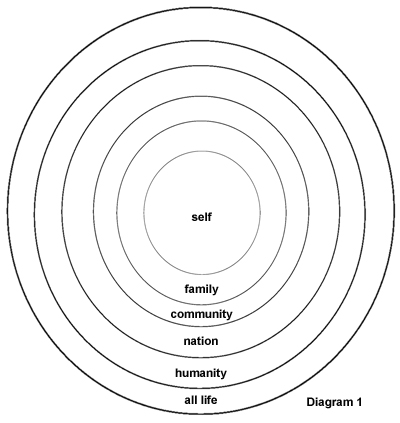 We can begin by assuming that the wider the perspective an individual has, the more mature, and therefore the more awake, she is. Consider the accompanying diagram, which roughly depicts the stages of human cognitive growth. The child begins by becoming aware of self, then of family, community, nation, the whole of humanity, and possibly even all sentient life.
We can begin by assuming that the wider the perspective an individual has, the more mature, and therefore the more awake, she is. Consider the accompanying diagram, which roughly depicts the stages of human cognitive growth. The child begins by becoming aware of self, then of family, community, nation, the whole of humanity, and possibly even all sentient life.
The schema here is crude and somewhat arbitrary. There are countless other collectivities that someone may identify with: for many children, the first community they are aware of is school. Nor are these categories universal; other cultures may break them down in different ways. In some primitive tribes, members are classed by an animal totem: an individual is of the deer people, the turtle people, and so on. Among the Chippewa Indians of the American Midwest and Canada, for example:
All members with the same totem regarded themselves as related even though of different villages or different tribes . . . When two strangers met and found themselves to be of the same totem they immediately began to trace their genealogy . . . and the one became the cousin, the uncle, or the grandfather of the two, although the grandfather might often be the younger of the two. (Lévi-Strauss, 167)
The bond of the totem is so strong that if a man witnesses a quarrel, he will immediately side with the individual with his own totem, even if the other person is a close relative of his.
The anthropologist Claude Lévi-Strauss says that this identification with a totem animal “sometimes goes beyond the limits of humanity in a biological, and no longer a merely sociological, sense” (ibid.). Certain Australian aborigines with a dog totem, for example, will describe dogs as “sons” and “brothers”—meaning that members may consider them as more a part of their family than other humans.
In more developed cultures, a common religion can create a sense of unity beyond national or ethnic borders. One famous case was that of civil rights leader Malcolm X. Although he had been a prominent leader of the Black Muslim movement—which teaches that the white man is evil—he experienced a change of heart in 1964 on the traditional pilgrimage to Mecca. He described his experience at the Frankfurt airport, waiting for a plane with other pilgrims: “Throngs of people, obviously Muslims from everywhere, bound for the pilgrimage, were hugging and embracing. They were of all complexions, the whole atmosphere was of warmth and friendliness. The feeling hit me that there really wasn’t any color problem here. The effect was as though I had just stepped out of a prison.”
On the other hand, such perceived bonds sometimes generate confusion. When I was traveling in Egypt with my then-girlfriend in 1979, we hired a guide named Mr. Hanna to show us around the sites of Luxor. Mr. Hanna was a Coptic Christian and was much friendlier toward us than were the Muslim Egyptians. He assumed that, being from the West, we were Christians too. But my girlfriend, whose parents were atheists, was not a Christian and had never been baptized. Mr. Hanna could not understand this at all.
We might assume that this journey outward from the circle of self to the circle of universality will proceed normally and naturally. Such is not always the case. The progression can be arrested at any point.
The problem is easiest to see from extreme examples, such as sociopaths. There are not many sociopaths, but there are certainly some. Figures from the Web put them at between 1 and 3 percent of the population. Sociopaths never proceed beyond the inmost circle of the self. They are often defined as people without a conscience. They are incapable of sympathy or empathy. Nor do they feel affection.
The sociopath has no sense of connection with other people. Emotionally, he is completely isolated from everyone else. He lives for himself alone. And he does not mind. Other people are only things to be used instrumentally.
It is grim to consider that a large number of the most powerful people in the world are very likely sociopaths.
We generally see the sociopath as an individual, an isolated case, the victim of some early trauma or damage. But this progression outward can be arrested at other stages as well, and the process may go beyond the individual to the collective.
Consider the family in Italian society. Author Luigi Barzini writes in his insightful book The Italians:
The Italian family is a stronghold in a hostile land: within its walls and among its members, the individual finds consolation, help, advice, provisions, loans, weapons, allies and accomplices to aid him in his pursuits . . . Scholars have always recognized the Italian family as the only fundamental institution in the country . . . In fact, the law, the State, and society function only if they do not directly interfere with the family’s supreme interests . . .
There were times in [Italy’s] past, and even in recent, almost contemporary history, when the State was at its lowest and weakest, impoverished and defeated, and yet the inhabitants were feverishly active, happy, and prosperous. (Barzini, 190)
Barzini goes on to say that in Italy, the family has been a “private lifeboat in the stormy seas of anarchy.”
All well and good, but there is a flip side to this situation. The family has been reinforced to the detriment of a larger social order:
Anarchy in Italy is not simply a way of life, a spontaneous condition of society, a natural development: it is also the deliberate product of man’s will, the fruit of his own choice; it has been assiduously cultivated and strengthened down the centuries. The strength of the family, therefore, is not only the bulwark against disorder, but, at the same time, one of its principal causes. (Barzini, 191)
Italy, fragmented for 1400 years into many little states, ruled variously by Vikings, Arabs, Spaniards, the French, the Austrians, and the Holy See, was often the plaything of larger powers. Small wonder, then, that the Italians took refuge behind the walls of their families. But at the same time the family kept them from going beyond the bounds of this refuge. In terms of the diagram, Italians collectively did not go past the second circle. Barzini is asking whether they did so because of the political storms that were always outside these walls, or whether the storms were partly caused by this isolation.
The United States presents the opposite case. The rule of law is strong here, public institutions are accountable and responsible (if imperfectly so), and there is a great sense of national identity and pride, as we see from the countless flags that are displayed at every conceivable location. The family, by contrast, is weak. To some extent this has been a self-selecting process. The vast majority of Americans either came here to get away from someplace else or are descended from people who did. Thus the population is naturally going to be skewed toward the mobile, the restless, the drifters. Americans are always on the move, and they have always been. In a nation like this, the family is comparatively insignificant, extolled between the last Thursday of November and the first day of January, but otherwise very much in the background.
Consequently, loneliness and isolation are central issues in our culture. Practically every major work of American literature is about this theme, whether you’re talking about crazy Ahab on the Pequod, Huck Finn on his raft down the Mississippi, or Jay Gatsby, friendless in his ostentatious mansion. Even when the family is in the foreground—as with the tormented Compsons in William Faulkner’s The Sound and the Fury—it seems only to reinforce its members’ sense of isolation.
So some cast about almost arbitrarily for something greater to be part of. You live in a certain city, and that city has a sports team, so you feel part of the community by being a fan of the team.
Sports fandom is mostly innocent. People get pleasure out of watching sports, and the thrill of having your team win usually balances out the disappointment of having it lose. Even when the team doesn’t win very often, fans can commiserate about how bad it is.
Of course there is nothing wrong with being a sports fan. But it often seems as if being a fan requires not only loving your own team, but hating the rival team. Often the second part is more fun than the first.
Sometimes it can get out of hand. In the Byzantine Empire—the eastern half of the Roman Empire that lasted for a thousand years after the fall of Rome itself—chariot racing was popular. There were two teams, the blues and the greens. The fans of these teams started to band together, and they started to fight. There were riots. There were even points at which the factions nearly brought the empire down.
So you can see how this sense of belonging to something greater than yourself can turn destructive. The Byzantine chariot factions are a comparatively rare example of this happening with sports fans. (Although as I write this in June 2016, the headlines are full of tales of brawls between English and Russian soccer fans in the European championship matches.) You can find many other examples with political parties, sects, religions, nations, and so on. Human history is largely the history of such conflicts.
In these instances the sense of these widening concentric circles—family, society, humanity—comes to a halt. And it can be halted at any point. Some people consider the whole world outside their own families as enemies to be feared and fought. Others feel that way about their villages, nations, religions.
In these cases the need for connection to a larger whole is dysfunctional. It stops before it’s supposed to. It leads to hatred, violence, atrocity.
Finally, there is the universal level. This can’t possibly be dysfunctional, can it?
It can. The problem is best expressed by the line from Charles Schultz’s Peanuts: “I love humanity. It’s people I can’t stand.” In my experience, there are many people dedicated to noble and high-minded causes who thereby feel justified in treating those immediately around them casually and even despicably. It is a hazard that is in fact likely to confront someone with such high ideals. It has by no means been absent from the Theosophical Society.
To take an example from literature, there is Mrs. Jellyby in chapter 4 of Dickens’s Bleak House: a middle-aged woman “with handsome eyes, though they had a curious habit of seeming to look a long way off. As if . . . they could see nothing nearer than Africa!” And in fact Mrs. Jellyby is so preoccupied with educating “the natives of Borrioboola-Gha, on the west bank of the Niger” that her house is in a state of squalor and her children miserable. She ignores her son when he falls down the stairs. The narrator says about the boy, “I did not know which to pity most—the bruises or the dirt.” Mrs. Jellyby explains, “The African project at present employs my whole time.”
There is something to be said for Christ’s command to “love thy neighbor.” “Neighbor” implies proximity, and those who are closest to us, not only by blood but also geographically, have claims upon us that more remote people do not have. In fact the more remote the problem, the less likely we are to do any good, despite our intentions. Reporter Claire Bennett wrote about relief efforts in the aftermath of the Nepal earthquake in 2015:
Ragtag brigades of well-intentioned do-gooders flooded the country: students, church congregations, individuals who had previously vacationed in the area, all clambering over one another looking for a way to make their mark and do good, but lacking either the skills or coordination to have an impact. Indeed, many ended up slowing down the aid efforts.
There were even reports of teams of doctors who arrived to help but were unable to feed themselves. This wave of unsolicited and poorly planned shipments of untrained people and donated goods was dubbed by some humanitarians “the second disaster”.
Advising would-be relief workers, Bennett added, “Remember that it is not about you. It is not about your love for the country and its people. Your feelings of guilt and helplessness may be difficult to deal with, but you may not be what is needed right now” (emphasis hers).
From another angle, it is important to be humane to animals. But many of the people I have known who are obsessed with animal welfare show a strong streak of misanthropy.
Thus any level of identification can be misguided or pathological. This suggests a need for some balance among all these levels. Self-interest is legitimate, but it is not absolute. So are family, society, nation, religion, humanity—even beyond. You may feel compassion for all sentient beings, but if your house is overrun with vermin, you need to deal with the problem.
This kind of ethical balance has been more heavily underscored in the Eastern traditions than in the West. Hinduism has its concept of dharma—which is not only duty in our familiar sense but an understanding of one’s proper role in the universe and a willingness to take responsibility for that role. The Chinese tradition speaks of the chen jen, “true man,” who similarly exists in right relationship not only with his fellow humans, but with the cosmos.
It is a point that Christianity has rarely gotten right. Jesus, as portrayed in the Gospels, does not have a wife or children, and if he did, one suspects that, like the Buddha, he would not have paid much attention to them. (In fact this is how he acts toward his mother and his siblings.) He also says, “He that loveth father or mother more than me is not worthy of me: and he that loveth son or daughter more than me is not worthy of me” (Matthew 10:37). Contrary to what some claim, Jesus cared little for family values.
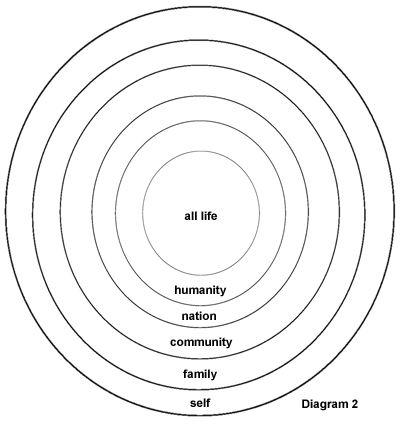 At the beginning of this article, I said that diagram 1 was crude and arbitrary. Diagrams are always treacherous. They oversimplify and distort; they conceal as much as they illumine. Thus we may learn something by turning it inside out (diagram 2).
At the beginning of this article, I said that diagram 1 was crude and arbitrary. Diagrams are always treacherous. They oversimplify and distort; they conceal as much as they illumine. Thus we may learn something by turning it inside out (diagram 2).
At first glance this schema looks completely counterintuitive. The collective, the unitive, as the inmost part of the self? That sounds absurd. But there may be more truth to it than one might suspect.
In the first place, it points up an extremely important but neglected fact: there are collective layers to the psyche. It’s easy to forget this in the present-day U.S., with its nearly pathological insistence on individualism. But in past times these levels were probably far more dominant than they are today. The Turkish Sufi master Refik Algan comments: “In the medieval ages, we had the type rather than the individual. In a village or a group of villages, people were almost the same as others. They felt almost the same things; they had the same songs, the same food; individual difference meant little” (Kinney and Smoley, 35). Today someone dresses to express herself as an individual. In those days people did not think of such things: they wore the clothing of their region, their village, to express themselves as part of a collective.
In a more developed stage of civilization, there was (and is) the nation. The nation is one of those concepts that evaporate the more closely you examine them. What exactly constitutes a nation? An ethnicity? A language? A history? A government? You don’t have to think very hard to realize that a nation is none of those things. As Hugh Seton-Watson, author of a highly respected text on nationalism, concedes, “I am driven to the conclusion that no ‘scientific definition’ of the nation can be devised; yet the phenomenon has existed and exists” (quoted in Anderson, 3; emphasis Seton-Watson’s). Nevertheless, as poorly understood as it is, there is a stratum of the individual psyche that is attuned to the psyche of this nation.
Note also that these collective levels run deeper than the merely personal. That helps explain why people rush so madly to sacrifice themselves for their nations, their faiths, and their allegiances. They feel these as part of themselves more deeply than they do the personal ego. Theosophist Arthur E. Powell portrays this collective as the crowd: “Crowds are in the main formed, nourished on, and dominated by feeling or emotion—not by thought” (Powell, Astral Body, 216).
I am not so sure. Certainly emotion plays an enormous part in the crowd mentality. But there are certain ideas that can take hold of a population with as much or more intensity than feelings per se. In the twentieth century such ideas as the dictatorship of the proletariat and the Master Race had this power. The same may be the case for the concept of jihad among certain radical elements of Islam today.
As a remedy, the Theosophical literature focuses on the conscious work of certain more or less awakened people. C.W. Leadbeater writes: “The power of the united thought of a number of people is always far greater than the sum of their separate thoughts . . . Hence it is exceedingly beneficial for any city or community that there should be constantly meeting in its midst a number of people who are capable of generating thoughts at a high level” (quoted in Powell, Mental Body, 48).
Finally we reach the center. There is something in you that is conscious, that is aware. It is not your body, nor is it even your thoughts and feelings, because you can step back inwardly and observe all these things as if from a distance (this is the point of many meditative practices). Here are some names for it: the Atman, the Self, Buddha nature, the kingdom of God, the Tiferet of the Kabbalists, “I am that I am.” It is there, and it can never go away—in fact, it is said, this is the only part of you that is truly immortal. As these examples suggest, this truth is known to practically all religions. Of course it is—because if it is true, it must be universally true, and many people will have discovered it in their own ways. Here is a description from the Hungarian spiritual teacher Georg Kühlewind:
This experience we call the “I-am experience.” It is the universal healing medicine. It is a feeling of identity with an ever-deepening being that wills itself. It provides certainty, creativity, and solidity, and dissolves what comes from egotism. From it, the knowledge arises that nothing can happen to me (the one who is experiencing this): I am safe, completely independent of circumstances, opinions, successes, or failures. I have found my spiritual roots. (Kühlewind, 39; emphasis Kühlewind’s)
There is a point at which one awakens to the true “I” within. But what relation does this transcendent “I” have to others? Many times you hear it said that “we are all one.” What could this possibly mean? In day-to-day life we are most assuredly not one. The advantage of one person is the disadvantage of the other. You get the girl, I don’t; I get the job, you don’t. We are linked only by our mutual interests and advantages. And yet the world’s traditions all teach us to “love thy neighbor as thyself.”
All of this only makes sense if we realize one thing: if you follow the “I” far enough into oneself —past all the levels of personal and collective identification—you reach “a feeling of identity with an ever-deepening being,” as Kühlewind says. This is the “I” that is “we.” At the core, the “I” that is in you is the same “I” that is in me, and indeed in all creation. (This may be one meaning of the Hindu axiom “Atman is Brahman.”) That is, ultimately your self-interest and mine are identical. You are to love your neighbor as yourself because at the core, your neighbor is yourself. In the words of the German mystic Meister Eckhart, “It is when one does not belong anymore to oneself that one is most oneself” (quoted in Aubry, 47).
If you understand these facts to some degree, consciously or not, you are healthy. If you don’t, you’re not.
This health expresses itself in such things as love, compassion, and empathy. I would go further. I would say it is the source of all true love, compassion, and empathy. All other forms of human relations are merely transactions.
If I’m right about these things, it explains something else. We now know why—for a normal person at any rate—it feels good to do kind things and to help others. It feels good for the same reason that sex feels good or sleep feels good. These are all the satisfactions of real organic needs.
Now it’s a bit more clear why being a kind person is, in a very deep sense, healthy for you.
If people could function normally in this sense, with a proper orientation toward the larger Self that is the human race and indeed the universe, most of the problems of the present would vanish. They would be seen simply as technical problems. And humanity has gotten very good at solving technical problems. It’s often said that there is enough money, resources, and know-how to end the environmental crisis and provide everyone on earth with a decent standard of living. But the will is not there. The will is not there because not enough people are connected to “the I that is we.”
SOURCES
Anderson, Benedict. Imagined Communities. Rev. ed. London: Verso, 1983.
Aubry, Gwenaëlle. “Plato, Plotinus, and Mysticism.” In Glenn Alexander Magee, ed. The Cambridge Handbook of Western Mysticism and Esotericism. New York: Cambridge University Press, 2016.
Barzini, Luigi. The Italians: A Full-Length Portrait Featuring Their Manners and Morals. New York: Simon & Schuster, 1964.
Bennett, Claire. “Don’t Rush to Nepal to Help. Read This First.” The Guardian, April 27, 2015; http://www.theguardian.com/commentisfree/2015/apr/27/earthquake-nepal-dont-rush-help-volunteers-aid; accessed June 16, 2016.
Dash, Mike. “Blue Versus Green: Rocking the Byzantine Empire,” Smithsonian.com, Mar. 2, 2012; www.smithsonianmag.com/history/blue-versus-green-rocking-the-byzantine-empire-113325928/?no-ist; accessed Nov. 3, 2015.
Kinney, Jay, and Richard Smoley. “The Goal of Oneness: The Gnosis Interview with Refik Algan.” Gnosis 41 (winter 1994), 34–39.
Kühlewind, Georg. The Light of the “I”: Guidelines for Meditation. Great Barrington, Mass.: Lindisfarne, 2008.
Lévi-Strauss, Claude. The Savage Mind. Chicago: University of Chicago Press, 1966.
Moss, Richard. The I That Is We: Awakening to Higher Energies through Unconditional Love. Berkeley, Calif.: Celestial Arts, 1981.
Powell, Arthur E. The Astral Body and Other Astral Phenomena. Wheaton: Theosophical Publishing House, 1996 [1927].
———. The Mental Body. Adyar: Theosophical Publishing House, 2000.
Tristan, Pierre. “Malcolm X in Mecca,” About.com, Dec. 26, 2015; http://middleeast.about.com/od/religionsectarianism/a/me080220b.htm; accessed June 14, 2016.
Richard Smoley’s latest book, How God Became God: What Scholars Are Really Saying about God and the Bible, was reviewed in Quest, summer 2016, and is available now.
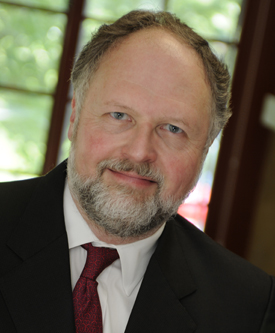 National secretary David Bruce reminds me that this year is the 400th anniversary of the death of Shakespeare. Which raises a question: what exactly was Shakespeare’s worldview?
National secretary David Bruce reminds me that this year is the 400th anniversary of the death of Shakespeare. Which raises a question: what exactly was Shakespeare’s worldview?

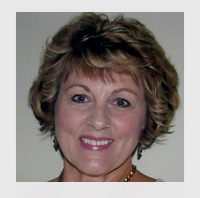 The call came at 2:15 a.m. It was my first on-call summons since I had become a hospice nurse a month earlier. I dressed quickly, running a comb through my sleep-flattened hair, feeling more than a little as firemen do as they jump into their boots and slide down the pole when the alarm sounds. I reviewed the patient’s name and address and the message the triage nurse had given me on the phone: “Madeline D. is close to dying. Her family is expecting you as soon as you can get there.” On the way, I carefully remembered what I had been taught to do when I arrived. My heart would tell me what to say.
The call came at 2:15 a.m. It was my first on-call summons since I had become a hospice nurse a month earlier. I dressed quickly, running a comb through my sleep-flattened hair, feeling more than a little as firemen do as they jump into their boots and slide down the pole when the alarm sounds. I reviewed the patient’s name and address and the message the triage nurse had given me on the phone: “Madeline D. is close to dying. Her family is expecting you as soon as you can get there.” On the way, I carefully remembered what I had been taught to do when I arrived. My heart would tell me what to say.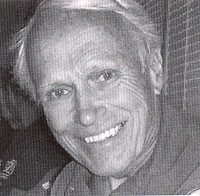 For many years I believed that retirement was only a sad commentary on the unpleasantness of most work. After all, if work is an unpleasant necessity and to be avoided, as it is for many, then why not seek relief at every opportunity? Weekends are to the work week as vacation is to the year, as retirement is to a life’s work. The assumption is that leisure is what’s enjoyable and work is the price one pays to get it. The solution, of course, is to have not just a job but a satisfying life’s work, thereby blurring the distinction between work and nonwork.
For many years I believed that retirement was only a sad commentary on the unpleasantness of most work. After all, if work is an unpleasant necessity and to be avoided, as it is for many, then why not seek relief at every opportunity? Weekends are to the work week as vacation is to the year, as retirement is to a life’s work. The assumption is that leisure is what’s enjoyable and work is the price one pays to get it. The solution, of course, is to have not just a job but a satisfying life’s work, thereby blurring the distinction between work and nonwork. We can begin by assuming that the wider the perspective an individual has, the more mature, and therefore the more awake, she is. Consider the accompanying diagram, which roughly depicts the stages of human cognitive growth. The child begins by becoming aware of self, then of family, community, nation, the whole of humanity, and possibly even all sentient life.
We can begin by assuming that the wider the perspective an individual has, the more mature, and therefore the more awake, she is. Consider the accompanying diagram, which roughly depicts the stages of human cognitive growth. The child begins by becoming aware of self, then of family, community, nation, the whole of humanity, and possibly even all sentient life. At the beginning of this article, I said that diagram 1 was crude and arbitrary. Diagrams are always treacherous. They oversimplify and distort; they conceal as much as they illumine. Thus we may learn something by turning it inside out (diagram 2).
At the beginning of this article, I said that diagram 1 was crude and arbitrary. Diagrams are always treacherous. They oversimplify and distort; they conceal as much as they illumine. Thus we may learn something by turning it inside out (diagram 2).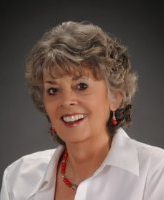 The New Testament tells of a father who approached Jesus out of a crowd, begging him to cure his afflicted son. The young man suffered from fits that often caused him to fall on the ground, gnash his teeth, and foam at the mouth.
The New Testament tells of a father who approached Jesus out of a crowd, begging him to cure his afflicted son. The young man suffered from fits that often caused him to fall on the ground, gnash his teeth, and foam at the mouth.